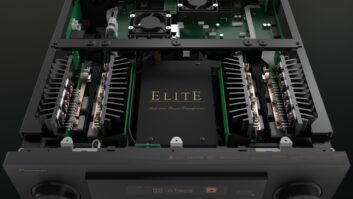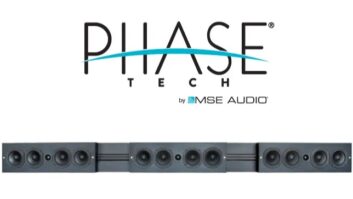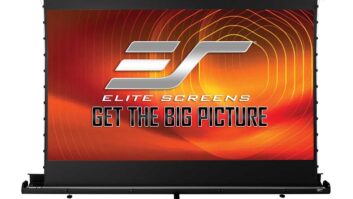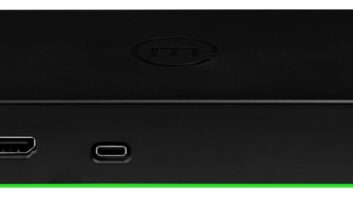Home networking and custom installation were top of mind at Pioneer when it designed its new Elite series A/V products.
The company added DLNA (Digital Living Network Alliance) network-compatibility standards in three Elite series plasmas TVs for the first time and to its first Blu-ray Disc player, all of which are also Microsoft PlaysForSure-certified during its recent line preview, here. (See p. 1.) The standards are not incorporated in plasmas in the mainstream Pioneer series.
All four of the new Elite A/V receivers continue key features in demand by custom installers, including custom features added for the first time in the previous Elite selection, said senior marketing VP Russ Johnston. Receiver sell-in through existing Elite dealers grew last year because of the additions, he said.
The company’s seven-channel Elite receivers, street-priced from $650 to $1,500, include such custom features as multiroom, multisource capabilities, RS232 port for PC and control connectivity. The $650 and $950 models are two-zone receivers whose internal amps power a 5.1-channel home theater while simultaneously driving two-channel music in another room. The top two models at $1,200 and $1,500 are three-zone receivers whose internal amps will drive a 5.1 system and a two-channel music source. The third zone is supplied by the receiver’s digital output and an outboard amp.
The receivers, which are all THX Select2-certified, includes Pioneer’s first two receivers that up-scale video sources to 480p, 720p and 1,080i high definition. All four are also the company’s first receivers to pass through 1,080p video. The new series also expands iPod controls to three SKUs from two, and XM Satellite Radio controls to four SKUs from two. The Elite series also gets Neural Surround decoding for the first time to deliver select XM channels and select analog and digital FM broadcasts in discrete 5.1-channel surround. It is available in all four.
To control iPods through three Elite receivers’ onscreen display and remote, Pioneer launched a $99 charging/docking station. The company also launched a $99 iPod charging/docking station for connection to any A/V receiver. That dock generates an onscreen display for use with any receiver and comes with its own remote. iPod controls in Elite receivers now start at $950 street price.
To improve the sound quality of compressed music stored on iPods, Pioneer incorporates “sound retriever” processing that restores lows and highs in compressed music.
All of the receivers feature HDMI 1.2 inputs ands outputs, although the HDMI inputs on the $650 model carry only video. The other receivers’ HDMI inputs transport audio and video, including DVD-Audio streams but not SACD streams. All but the opening-price model up-convert all video inputs to an HDMI output. The opening-price model up-converts to component video, Pioneer said. Each model features automatic room correction.
The top three ship in late June, and the opening-price model ships in July.
In its mainstream Pioneer series, meanwhile, the company expanded its selection of XM-ready A/V receivers with Neural Surround to two SKUs with the addition of a $499 (street price) model to complement a $299 model shipped earlier this year. The $499 model adds 1,080p passthrough, among other features.
“In another month, we’ll know the timing of” the launch of Pioneer A/V receivers that control outboard Sirius and XM tuners, said Johnston. It won’t be this year, however. Pioneer’s contract with XM, he noted, doesn’t necessarily mandate a two-year wait period between the launch of Pioneer’s first XM-ready receiver and the launch of a Sirius/XM-ready receiver.
To connect to a home Ethernet network, Pioneer introduced a trio of Elite plasma TVs whose DLNA certification enables them to connect seamlessly with other networked devices and with a networked PC (incorporating Windows Media Connect and Windows XP Service Pack 2). The plasmas incorporate decoders for the MP3 and WMA audio formats and possibly others, but not Apple’s FairPlay-protected AAC files, the company said. Because the devices are PlaysForSure-certified, they can play protected WMA files, including WMA subscription downloads. Video decoders include, but aren’t limited to, MPEG-1, MPEG-2, MPEG-4 and VC-1, or high-definition WMV. The three can be upgraded via future PC download to add additional codec support.
Over a wired Ethernet network, multiple Elite devices can simultaneously stream at least two separate video streams from a networked PC. All streams can be selected and controlled from the Elite device’s IR remote.
The Elite plasma trio and the Blu-ray player also feature Home Media Gallery to display images stored on an inserted USB drive. Users can rotate, scroll, zoom in and out or view a complete slideshow via remote control.
The plasmas will appear in 42-inch, 50-inch and 60-inch screen sizes; the former two will ship in August, and the latter will ship in September at a target street price of about $7,000. All feature ATSC and NTSC tuners and 1,080p inputs. The top two models feature detachable speakers, while the speakers in the 42-inch model are integrated because the display is targeted for secondary-room use.
The Blu-ray player is due in September at a street price of about $1,500
In another development, the company said its Blu-ray Disc player, like Sony’s model, will support only the mandatory Blu-ray surround-sound codecs, which are Dolby Digital 5.1, DTS 5.1 and 5.1-channel PCM up to 192kHz sampling rate with 24-bit resolution. The player doesn’t pass through Blu-ray’s optional surround formats, which are Dolby Digital Plus, DTS HD, 7.1-channel PCM, Dolby TruHD and DTS HD Master
As with the Sony player, mandatory surround-sound soundtracks can be delivered digitally to the audio decoders in an A/V receiver via its HDMI output, 5.1 analog outputs and digital S/PDIF output (although multichannel PCM is downconverted to two-channel PCM for streaming through the S/PDIF).
Delivery of optional codecs through an HDMI output awaits availability early next year of HDMI 1.3 silicon, which could appear in high-definition disc players and A/V receivers as early as the summer of 2007, said Johnston.
Initial Blu-ray Discs mainly feature Dolby and DTS 5.1 soundtracks, but multichannel PCM is included on some, Johnston said.













